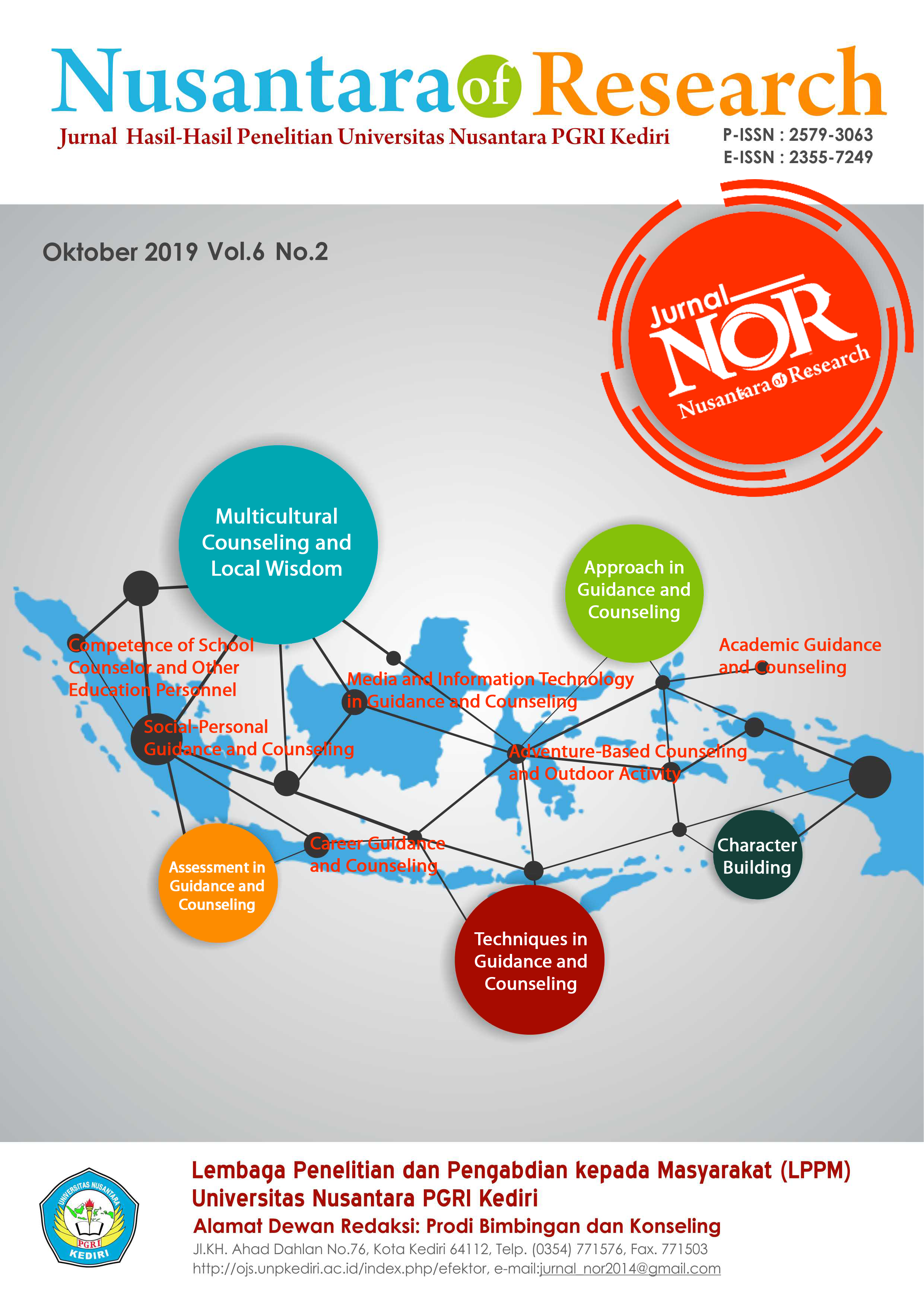Pengembangan Media Google Site dalam Bimbingan Klasikal di SMAN 1 Sampung
Main Article Content
Abstract
This development aims to produce a classical guidance media that can be accessed through smartphones and meets the elements of eligibility through expert user trials, and field trials. In addition, through this development activity, it is also expected to provide positive internet content. The development model adapts the ASSURE concept, namely through steps: analyzing students' characteristics, standards and goals, choosing strategy-technology-media and materials, using technology, media and materials, requiring student participation, evaluating and revising. The feasibility test, based on the ACTIONS concept, produces a score of 317 with a maximum score of 340, the eligibility level reaches 93%. While from the field test conducted in XII Science 1 with the main focus of observation on the active behavior, the total score is 1417 with a maximum score of 1450, the level of activity is 97.72%. Based on the results of expert tests by certified BK teachers and data from field test results, it was found that the website with google site was accepted and suitable as a classical guidance media. To get wider benefits it is recommended to arrange media for other material content.
Downloads
Article Details
Issue
Section
Authors who publish with this journal agree to the following terms:
- Copyright on any article is retained by the author(s).
- The author grants the journal, the right of first publication with the work simultaneously licensed under a Creative Commons Attribution License that allows others to share the work with an acknowledgment of the work’s authorship and initial publication in this journal.
- Authors are able to enter into separate, additional contractual arrangements for the non-exclusive distribution of the journal’s published version of the work (e.g., post it to an institutional repository or publish it in a book), with an acknowledgment of its initial publication in this journal.
- Authors are permitted and encouraged to post their work online (e.g., in institutional repositories or on their website) prior to and during the submission process, as it can lead to productive exchanges, as well as earlier and greater citation of published work.
- The article and any associated published material is distributed under the Creative Commons Attribution-ShareAlike 4.0 International License
How to Cite
References
Bhakti, Caraka Putra & dkk, 2018, Blended Learning: Metode Alternatif Dalam Layanan Bimbingan Klasikal, Prosiding Online seminar nasional dan Workshop Bimbingan dan konseling 2018 UNISKA.
Bangun, Br Nurita dan Saragih, A Hasan. 2015. Pengembangan Media Web Bimbingan Konseling. Jurnal Teknologi Informasi dan Komunikasi dalam Pendidikan, Vol 2, No 1, Juni 2015, p-ISSn: 2355-4983; e-ISSN: 2407-7488. Diakses pada tanggal 7 Agustus 2019 pada laman https://jurnal.unimed.ac.id/2012/index.php/teknologi/article/view/3285/2953.
Bates, A.W. (1995) Technology, open learning and distance education. London: Routledge.
Google site. sagusanove sites. diakses pada 7 Agustus 2019, dari https://sites.google.com/view/sitessagusanov/beranda.
Google site. tutorial site .diakses pada 7 Agustus 2019, dari https://Site.google.com/site/tutorialSiteums/definisi.
Heinich, R., Molenda, M., dan Russel, J. (2005). Instructional Technology and Media of Learning. New Jersey: Meril Prentice Hall.
Kemendikbud, 2016. Panduan Operasional Penyelenggaraan Bimbingan dan Konseling Sekolah Menengah Atas (SMA). Kementerian Pendidikan dan Kebudayaan Direktorat Jenderal Guru dan Tenaga Kependidikan.
Kemendikbud. 2016. Pedoman BK Pada Pendidikan Dasar dan Pendidikan Menengah. Kementerian Pendidikan dan Kebudayaan Direktorat Jenderal Guru dan Tenaga Kependidikan.
Kemendikbud. 2008. Peraturan Menteri Pendidikan Nasional Nomor 27 Tahun 2008 tentang Standar Kualifikasi Akademik dan Kompetensi Konselor. Jakarta: Kementerian Pendidikan dan Kebudayaan.
Rakhmawati, Dini. 2017. Konselor Sekolah Abad 21: Tantangan dan Peluang. Jurnal Konseling GUSJIGANG Vol. 3 No. 1 (Januari-Juni 2017) Print ISSBN 2460-1187, Online ISSBN 2503-281X. Diakses pada tanggal 7 Agustus 2019 melalui laman https://jurnal.umk.ac.id/index.php/gusjigang/article/download/1067/1065
Rudi, S., & Cepi, R. (2008). Media Pembelajaran. Bandung: Jurusan Kurtekpend FIP UPI.
Sanjaya, Wina (2008). Perencanaan Dan Desain Sistem Pembelajaran. Bandung: Kencana.
Susana, Tjipto. 2012. Kesetiaan pada Panggilan di Era Digital. Orientasi Baru. Vol. 21. No. 1. Hal. 55-78.
Zimoek, 2016, School Counseling Classroom Guidance: Prevention, Accountability, and Outcomes, Counseling and Professional Identitiy, America.




